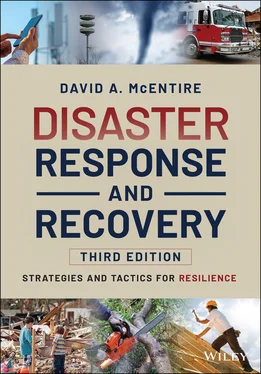David A. McEntire - Disaster Response and Recovery
Здесь есть возможность читать онлайн «David A. McEntire - Disaster Response and Recovery» — ознакомительный отрывок электронной книги совершенно бесплатно, а после прочтения отрывка купить полную версию. В некоторых случаях можно слушать аудио, скачать через торрент в формате fb2 и присутствует краткое содержание. Жанр: unrecognised, на английском языке. Описание произведения, (предисловие) а так же отзывы посетителей доступны на портале библиотеки ЛибКат.
- Название:Disaster Response and Recovery
- Автор:
- Жанр:
- Год:неизвестен
- ISBN:нет данных
- Рейтинг книги:5 / 5. Голосов: 1
-
Избранное:Добавить в избранное
- Отзывы:
-
Ваша оценка:
- 100
- 1
- 2
- 3
- 4
- 5
Disaster Response and Recovery: краткое содержание, описание и аннотация
Предлагаем к чтению аннотацию, описание, краткое содержание или предисловие (зависит от того, что написал сам автор книги «Disaster Response and Recovery»). Если вы не нашли необходимую информацию о книге — напишите в комментариях, мы постараемся отыскать её.
The new edition of the standard textbook in the field, updated with new studies and practical guidelines for reacting to the complexities of today’s disasters Disaster Response and Recovery: Strategies and Tactics for Resilience
Disaster Response and Recovery: Strategies and Tactics for Resilience, Third Edition
Disaster Response and Recovery — читать онлайн ознакомительный отрывок
Ниже представлен текст книги, разбитый по страницам. Система сохранения места последней прочитанной страницы, позволяет с удобством читать онлайн бесплатно книгу «Disaster Response and Recovery», без необходимости каждый раз заново искать на чём Вы остановились. Поставьте закладку, и сможете в любой момент перейти на страницу, на которой закончили чтение.
Интервал:
Закладка:
CASE STUDY
Community Emergency Response Teams
Some of the public are members of Community Emergency Response Teams (CERTs) (Franke and Simpson 2004). A CERTis a group of concerned citizens that receive some basic training about disasters from local governments ( Figure 2‐8). This enables them to care for their neighbors and coworkers after a disaster and buy time until formal assistance arrives. CERTs are different than certain types of nonprofit organizations in that they have no paid employees. They also have a greater interest in disaster issues than many other community groups.
CERTs first appeared in California in 1985. At this time, it was recognized that first responders would not be able to satisfy all of the needs of survivors who were affected by major earthquakes. Public officials realized that damaged roads, the large numbers of people impacted, and a shortage of trained professionals would prohibit or limit needed care for disaster victims. There was consequently a desire to educate citizens to be self‐sufficient for at least 72 hours after a disaster occurred. The CERT program was accordingly created to provide this type of training to members of the community.

Figure 2‐8 Community Emergency Response Teams (CERTs) add flexibility to response and recovery operations. After a tornado affected Rowlett, TX, CERT members helped to remove debris. In other disasters, they may fill sandbags, direct traffic or perform other important functions. FEMA.
Since this time, CERTs have been established around the nation by publicizing training opportunities and accepting applications from interested volunteers. CERTs are often created in areas that deserve special attention. This might include a neighborhood that is located far away from city resources, an elderly community that has unique medical needs, and a community college or university that has a transient population. Participants accepted into the CERT program undergo training that usually consists of several 2½ to 4‐hour classes over a 7 or 8‐week period. Classes address the types of disasters that are to be expected, basic preparedness measures, fire suppression techniques, search and rescue operations, disaster medicine, and disaster psychology. After the 9/11 attacks, more attention was given to terrorism and the special situations that they might generate for response and recovery.
The training of CERT teams is funded by government grants. This funding may also help CERT members obtain basic equipment such as hard hats, gloves, and other supplies that might be useful in time of a disaster. Because of this federal support, there are now over 2,700 CERT programs in states throughout the nation. The value of CERTs is increasingly recognized by those involved in EM since they may be able to help victims in need and ease the burden on official first responders.
Self‐Check
What are nonprofit organizations?
What are the most prominent nonprofit organizations that are involved in disasters and what do they do?
What is a faith‐based organization and how do they relate to disasters?
What are the community groups in your community that could help with response and recovery operations?
What is a CERT?
How could CERTs help you as an emergency manager?
How could the NVOAD assist with coordination?
2.4 Emergent Groups
All types of people may become involved in a variety of post‐disaster activities ranging from volunteering to the contribution of donations. As an emergency manager, you must be aware that citizens will be some of the first people to respond to disasters when they occur. Generally, they are located at scene of an incident since they are present everywhere – at home, at work, at school, at the grocery store or at the ballpark.
Citizens fulfill an important niche in response and recovery operations. After virtually all emergencies and disasters, citizens create and participate in emergent groups. Emergent groupsare individuals who work together to perform common goals but do not yet have a formalized organization (Stallings and Quarantelli, 1985, p. 84). Put differently, an emergent group is a collection of people that unite for the sole purpose of addressing disaster needs. The people that make up emergent groups become involved in activities that they have never performed before or do not participate in frequently. Emergent organizations are typically disbanded once the emergency situation is resolved. In some cases, however, the emergent organization is formalized and becomes a permanent part of the emergency management organizational landscape.
Scholars have long recognized the role of emergent groups in disasters. Samuel Prince, a doctoral student at Columbia University, examined an explosion that occurred when a French munitioner ran into a Belgian relief ship in a harbor in Halifax, Canada during World War I. His dissertation is the forerunner of modern disaster sociology. It illustrated that strangers, friends, relatives, neighbors, and even the victims themselves interact to care for the injured, gather the dead, and fulfill other important post‐disaster actions.
For Example
Public Response to the Loma Prieta Earthquake
On October 17, 1989, a massive earthquake shook the cities of Santa Cruz and San Francisco. The earthquake registered 7.1 on the Richter scale. Research by O’Brien and Mileti (1992) revealed that roughly 65% of citizens in these communities took part in disaster response activities. Nearly 200,000 people donated water and food to victims. 71,000 people supported the victims’ emotional needs. Another 31,500 took part in search and rescue operations. Citizens also cared for the wounded, cleared debris, and sheltered those in need. The major lesson from this disaster is that people living in affected or nearby locations are resources that can and will be utilized to address urgent disaster needs.
Since the time of Prince’s dissertation, emergent groups and the behavior they exhibit have been studied extensively (Rodriguez, Trainor and Quarantelli 2006; Quarantelli 1996). Their unique features and activities have been characterized in a variety of ways (see Drabek and McEntire, 2003, p. 98):
Therapeutic community. Citizens come together to promote healing and rehabilitation.
Synthetic community. People working together to resolve major challenges.
Mass assault. A massive response that can sometimes be overwhelming.
Altruistic community. Selfless acts to help and assist others.
Utopian community. Harmonious relations that may exist for a short time right after a disaster.
Emergence. The appearance of new organizations in time of crisis.
Emergent behavior. The pursuit of tasks that are new and unfamiliar.
Research also reveals that emergent groups are most likely to appear when there have been insufficient steps for preparedness, when disasters are especially severe, when there is a perception of dire need, and when people place blame for what has happened. Culture, socioeconomic status, and other factors may also determine the formation and purpose of groups. Such determinants may include religion, gender, and race and ethnicity.
Once formed, emergent groups may become involved in search and rescue operations, damage assessment, shelter provision, emotional support for victims and other relief activities. As a result, these spontaneous organizations are beneficial for disaster response and recovery. They are typically present at the scene, even before most EMTs, police officers and fire fighters. Emergent groups may organize themselves quickly (and later, more formally) to address the needs made evident by disaster. Emergent groups possess diverse skills and have a deep commitment to the cause. They also provide an impressive number of volunteers that can be harnessed in times of disaster.
Читать дальшеИнтервал:
Закладка:
Похожие книги на «Disaster Response and Recovery»
Представляем Вашему вниманию похожие книги на «Disaster Response and Recovery» списком для выбора. Мы отобрали схожую по названию и смыслу литературу в надежде предоставить читателям больше вариантов отыскать новые, интересные, ещё непрочитанные произведения.
Обсуждение, отзывы о книге «Disaster Response and Recovery» и просто собственные мнения читателей. Оставьте ваши комментарии, напишите, что Вы думаете о произведении, его смысле или главных героях. Укажите что конкретно понравилось, а что нет, и почему Вы так считаете.












